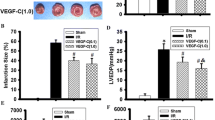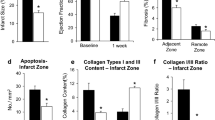Abstract
In our study, resveratrol (polyphenol) has been identified as a very important stimulus/agent for the induction of new vessel growth. Occlusion of a main coronary depletes the blood supply to the myocardium and subsequently reduces cardiac function, which ultimately leads to heart failure. Progressive, chronic coronary artery occlusion has been shown to induce development of collateral arteries to re-establish and maintain blood flow to the myocardium at risk via the growth of new capillary vessels or angiogenesis. Studies from our laboratory, as well as from others, have already confirmed the protective role of collaterals against myocardial ischemia and cell death. We have successfully demonstrated in rat myocardial infarction (MI) model an effect of resveratrol on significant upregulation of the protein expression profiles of vascular endothelial growth factor (VEGF) and its tyrosine kinase receptor Flk-1,3 wk after MI. Pretreatment with resveratrol also increased nitric-oxide synthase (inducible NOS and endothelial NOS) along with increased antiapoptotic and proangiogenic factors nuclear factor (NF)-κB and specificity protein (SP)-1. We also were able to demonstrate increased capillary density as well as improved left ventricular function by pharmacological preconditioning with resveratrol 3 wk after MI.
Similar content being viewed by others
References
Criqui, M. H. and Ringel, B. L. (1994) Does diet or alcohol explain the French paradox? Lancet 344, 1719–1723.
Goldberg, D. M., Tsang, E., Karumanchiri, A., Diamandis, E., Soleas, G., and Ng, E. (1996) Method to assay the concentrations of phenolic constituents of biological interest in wines. Anal. Chem. 68, 1688–1694.
Gonzalez-Candelas, L., Gil, J. V., Lamuela-Raventos, R. M., and Ramon, D. (2000) The use of transgenic yeasts expressing a gene encoding a glycosyl-hydrolase as a tool to increase resveratrol content in wine. Int. J. Food Microbiol. 59, 179–183.
Ray, P. S., Maulik, G., Cordis, G. A., Bertelli, A. A., Bertelli, A., and Das, D. K. (1999) The red wine antioxidant resveratrol protects isolated rat hearts from ischemia reperfusion injury. Free Radic. Biol. Med. 27, 160–169.
Hattori, R., Otani, H., Maulik, N., and Das, D. K. (2002) Pharmacological preconditioning with resveratrol: role of nitric oxide. Am. J. Physiol. 282, H1988-H1995.
Parenti, A., Morbidelli, L., Cui, X. L., et al. (1998) Nitric oxide is an upstream signal of vascular endothelial growth factor-induced extracellular signal-regulated kinase1/2 activation in postcapillary endothelium. J. Biol. Chem. 273, 4220–4226.
Morbidelli, L., Chang, C. H., Douglas, J. G., Granger, H. J., Ledda, F., and Ziche, M. (1996), Nitric oxide mediates mitogenic effect of VEGF on coronary venular endothelium. Am. J. Physiol. 270, H411-H415.
Ziche, M., Morbidelli, L., Choudhuri, R., et al. (1997) Nitric oxide synthase lies downstream from vascular endothelial growth factor-induced but not basic fibroblast growth factor-induced angiogenesis. J. Clin. Investig. 99, 2625–2634.
Maruyama, K., Mori, Y., Murasawa, S. et al. (1999) Interleukin-1 β upregulates cardiac expression of vascular endothelial growth factor and its receptor KDR/flk-1 via activation of protein tyrosine kinase. J. Mol. Cell. Cardiol. 31, 607–617.
Banai, S., Shweiki, D., Pinson, A., Chandra, M., Lazarovici, G., and Keshet, E. (1994) Upregulation of vascular endothelial growth factor expression induced by myocardial ischemia: implication for coronary angiogenesis. Cardiovasc. Res. 28, 1176–1179.
Hashimoto, E., Ogita, T., Nakaoka, T., Matsuoka, R., Takao, A., and Kira, Y. (1994) Rapid induction of vascular endothelial growth factor expression by transient ischemia in rat heart. Am. J. Physiol. 267, H1948-H1954.
Fukuda, S., Kaga, S., Sasaki, H., et al. (2004) Angiogenic signal triggered by ischemic stress induces myocardial repair in rat during chronic infarction. J. Mol. Cell. Cardiol. 36, 547–559.
Sasaki, H., Fukuda, S., Otani, H., et al. (2002) Hypoxic preconditioning triggers myocardial angiogenesis: a novel approach to enhance contractile functional reserve in rat with myocardial infarction. J. Mol. Cell. Cardiol. 34, 335–348.
Zhu, L., Fukuda, S., Cordis, G., Das, D. K., and Maulik, N. (2001) Anti-apoptotic protein survivin plays a significant role in tubular morphogenesis of human coronary arteriolar endothelial cells by hypoxic preconditioning. FEBS Lett. 508, 369–374.
Sasaki, H., Ray, P. S., Zhu, L., Otani, H., Asahara, T., and Maulik, N. (2001) Hypoxia/reoxygenation promotes myocardial angiogenesis via an NF κB-dependent mechanism in a rat model of chronic myocardial infraction. J. Mol. Cell. Cardiol. 33, 283–294.
Kelly, R. A., Balligand, J. L., and Smith, T. W. (1996) Nitric oxisde and cardiac function. Circ. Res. 79, 363–380.
Wildhirt, S. M., Suzuki, H., Horstman, D., et al. (1997) Selective modulation of inducible nitric oxide synthase isozyme in myocardial infarction. Circulation 96, 1616–1623.
Gaballa, M. A., Raya, T. E., Hoover, C. A., and Goldman, S. (1999) Effects of endothelial and inducible nitric oxide syntheses inhibition on circulatory function in rats after myocardial infarction. Cardiovasc. Res. 42, 627–635.
Rossig, L., Haendeler, J., Hermann, C., et al. (2000) Nitric oxide down-regulates MKP-3 mRNA levels: involvement in endothelial cell protection from apoptosis. J. Biol. Chem. 275, 25,502–25,507.
Dimmeler, S., Haendeler, J., Nehls, M, and Zeiher, A. M. (1997) Suppression of apoptosis by nitric oxide via inhibition of interleukin-1β-converting enzyme (ICE)-like and cysteine protease protein (CPP)-32-like proteases. J. Exp. Med. 185, 601–607.
van der Zee, R., Murohara, T., Luo, Z. et al. (1997) Vascular endothelial growth factor/vascular permeability factor augments nitric oxide release from quiescent rabbit and human vascular endothelium. Circulation, 95, 1030–1037.
Papapetropoulos, A., Garcia-Cardena, G., Madri, J. A., and Sessa, W. C. (1997) Nitric oxide production contributes to the angiogenic properties of vascular endothelial growth factor in human endothelial cells. J. Clin. Investig. 100, 3131–3139.
Le Cras, T. D., Xue, C., Rengasamy, A., and Johns, R. A. (1996) Chronic hypoxia upregulates endothelial and inducible NO synthase gene and protein expression in rat lung. Am. J. Physiol. 270, L164-L170.
Waltenberger, J., Claesson-Welsh, L., Siegbahn, A., Shibuya, M., and Heldin, C. H. (1994) Different signal transduction properties of KDR and Flt1, two receptors for vascular endothelial growth factor. J. Biol. Chem. 269, 26,988–26,995.
Kroll, J., and Waltenberger, J. (1988) VEGF-A induces expression of eNOS and iNOS in endothelial cells via VEGF receptor-2 (KDR). Biochem. Biophys. Res. Commun. 252, 743–746.
Bussolati, B., Dunk, C., Grohman, M., Kontos, C. D., Mason, J., and Ahmed, A. (2001), Vascular endothelial growth factor receptor-1 modulates vascular endothelial growth factor-mediated angiogenesis via nitric oxide. Am. J. Pathol. 159, 993–1008.
Zhuang, H., Kim, Y. S., Koehler, R. C., and Dore, S. (2003) Potential mechanism by which resveratrol, a red wine constituent, protects neurons, Ann. N. Y. Acad. Sci. 993, 276–278.
Juan, S. H., Cheng, T. H., Lin, H. C., Chu, Y. L., and Lee, W. S. (2005) Mechanism of concentration-dependent induction of heme oxygenase-1 by resveratrol in human aortic smooth muscle cells. Biochem. Pharmacol. 69, 41–48.
Author information
Authors and Affiliations
Corresponding author
Rights and permissions
About this article
Cite this article
Fukuda, S., Kaga, S., Zhan, L. et al. Resveratrol ameliorates myocardial damage by inducing vascular endothelial growth factor-angiogenesis and tyrosine kinase receptor Flk-1. Cell Biochem Biophys 44, 43–49 (2006). https://doi.org/10.1385/CBB:44:1:043
Issue Date:
DOI: https://doi.org/10.1385/CBB:44:1:043




